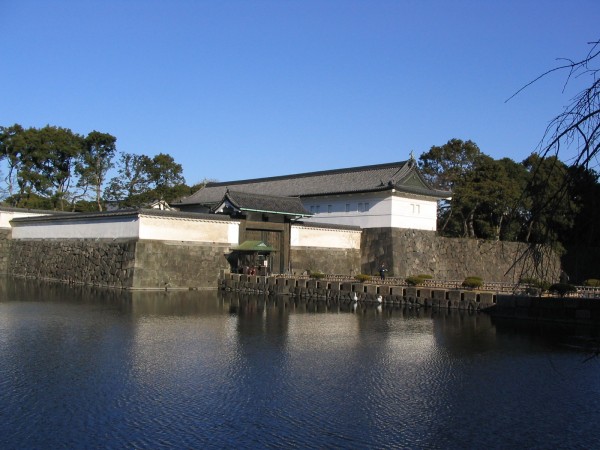IMPERIAL GARDENS, NHK MUSEUM OF BROADCASTING
![]() THURSDAY - TOKYO
THURSDAY - TOKYO
![]()
IMPERIAL GARDENS, NHK MUSEUM OF BROADCASTING
| I found out when I got there that the East Garden of the Imperial Palace complex, the only part open to the public, didn't open until 9:00 a.m. I was there an hour early, so I walked around the neighborhood. This is one of the gates. |
 |
| Little Japanese ducky-type birds. |
 |
| These buildings aren't ancient, but they have that classic Oriental architecture. |
 |
| A big bronze Japanese fellow. |
 |
| While the East Garden was not open, the Kitanomaru-koen park just across the street was. I don't think these are cherry blossoms, since it was a little too early for them. They are some other kind of blossoms. |
 |
| This guy was practicing his cornet next to the small pond. |
 |
| A big raven-type Japanese bird. |
 |
| The Nippon Budokan. It was built to host the judo competition for the 1964 Olympics, but is probably more known to Americans as the venue where musical acts such as The Beatles and Cheap Trick (remember the album At Budokan?) have played. |
 |
| It's 9:00 and the gates are open. Notice the sharp slope of the exterior wall as it towers over the moat. |
 |
| This is the remains of the first Tenshukaku donjon of Edo Castle. It was completed in 1638. It was the constructed under the authority of the Tokugawa Shogunate and was the highest tower built in Japan. It burned down in 1657 during the great fire that destroyed over two-thirds of the city. The tower was not rebuilt. |
 |
| The Ishimuro Stone Cellar. It was likely used as an emergency storehouse for supplies for the inner palace. |
 |
| The Fujimi-Tamon was an arsenal that sat atop a stone wall over one of the moats. This is the other side of course. |
 |
| Fujimi-Yagura. A yagura is a building for storage and defense. This was the only of the three remaining keeps that has three stories. It's just a neat-looking building. |
 |
| The Ōbansho was the great guardhouse, one of three guardhouses that still remain. As the final checkpoint, it was guarded by samurai guardsmen of higher rank than the others. |
 |
| There were vending machines on just about every street in every city and town I visited. These were on the Imperial Gardens grounds. Maybe this is where the emperor goes to get a bottle of tea or juice. |
 |
| Okay, I know different cultures have different traditions and such, but this is just strange to me. This is a Japanese toilet. Yes, it is basically a porcelain hole in the ground. What you are supposed to do is squat over the thing, facing the side with the hood, and do your business. It does flush, so it's a little more high-tech than a simple hole. Fortunately, most public toilets have Western-style toilets as well. I didn't use this contraption. Actually I just needed to use the urinal. From what I read, it's tricky to keep your balance trying to keep your pants out of the thing and everything from falling out of your pockets while squatting. |
 |
| The other side of that hedge is the off-limits. The building is a gymnasium. I could here martial arts noises coming from inside. |
 |
| Part of the garden contained symbolic prefectural trees. I'm not totally sure what that means, but from the look of them I'd say that they are trees from all the various prefectures (states to you and me) in Japan. |
 |
| I imagine these gardens are quite nice in the spring. |
 |
| Ninomaru Garden is a rather serene location, an escape from the hustle and bustle of busy Tokyo. |
 |
| Time to wave goodbye to the emperor's house. |
 |
| The NHK Museum of Broadcasting is on top of a big hill. There is a new elevator to take people to the top, but unfortunately I didn't know about it until I was going down. It was on this hill that JOAK began regular broadcasting in 1925. |
 |
| The display said this was the first television in Japan. I don't know if that means it was the first television in the country or the first Japanese-made set. It is funky looking though. |
 |
| A bunch of old radios. |
 |
| An iconoscope camera from 1939. |
 |
| This one is a bit newer than the other one. |
 |
| I have no idea what this was. The characters seem to represent different kinds of programming on the network. |
 |
| They do love their goofy animal costumes over there. There's a mouse, a penguin and whatever that thing is on the right. |
 |
| The chime and the gong were once used to announce the time on NHK. |
 |
| I cannot tell you why they have little figurines of George W. Bush and John Kerry. There was no English explanation for them. |
 |
| Puppets! |
 |
| More stuff from kids programming. |
 |
| More cameras. |
 |